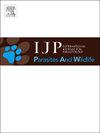Epidemiology and risk factors for endoparasite infection in subtropical feral cattle in Hong Kong
IF 2.2
3区 医学
Q3 ECOLOGY
International Journal for Parasitology-Parasites and Wildlife
Pub Date : 2025-05-15
DOI:10.1016/j.ijppaw.2025.101082
引用次数: 0
Abstract
Understanding parasite epidemiology is essential for managing endoparasite infections in free-ranging animals. However, such epidemiological knowledge is limited for feral cattle and is usually derived from farmed populations. We assessed endoparasite infection in a feral cattle population in Hong Kong. This population does not receive any routine care or anthelminthic treatment, although some cattle are provisioned with water and hay by local citizens. We assessed three indices of endoparasite infection (parasite richness, prevalence and fecal egg/oocyst count) and their associated risk factors (season, provisioning, marshland access, group size, sex and body condition) in adult cattle.
We conducted sedimentation, McMaster and coproculture techniques on 262 samples collected from 177 cattle. We identified eleven taxa of nematodes, two taxa of trematodes, one taxon of protozoan and one taxon of cestode. Median parasite richness was two parasite taxa per individual. Trematode infections were the most prevalent (91.22 %), followed by protozoan (67.17 %), nematode (23.22 %) and cestode (12.97 %) infections. Counts averaged 144.85 oocysts per gram for Eimeria oocysts, 20.61 eggs per gram (EPG) for strongyle-type eggs, 11.83 EPG for Moniezia and 1.91 EPG for Trichuris. Provisioned herds were more likely to be infected with Eimeria, but had lower prevalence of Trichostrongylus. Eimeria prevalence and strongyle-type egg counts were higher in the wet season, while Fasciola eggs, Cooperia and Trichostrongylus larvae were more prevalent in the dry season. Larger herds had higher Eimeria oocyst prevalence but lower Fasciola egg prevalence. Marshland access decreased Fasciola egg prevalence while it increased prevalence of Cooperia larvae. Males were more infected with strongyle-type eggs than female cattle.
We show that the seasonal dynamics of infection and consequences of provisioning differ between endoparasite taxa. Our findings highlight complex interactions between endoparasites and their hosts, providing new insights into wild ruminants’ health and the impacts of anthropogenic provisioning.

香港亚热带野牛体内寄生虫感染的流行病学及危险因素
了解寄生虫流行病学对管理自由放养动物体内寄生虫感染至关重要。然而,这种关于野生牛的流行病学知识是有限的,而且通常来自于养殖种群。我们评估了香港野生牛种群的内寄生虫感染。这群人没有得到任何常规护理或驱虫治疗,尽管一些牛由当地公民提供水和干草。我们评估了成年牛体内寄生虫感染的三个指标(寄生虫丰富度、流行率和粪卵/卵囊计数)及其相关危险因素(季节、供应、沼泽地通道、群体规模、性别和身体状况)。我们对177头牛采集的262个样本进行了沉淀、麦克马斯特和共养技术。鉴定出线虫类11个分类群、吸虫类2个分类群、原生动物1个分类群和寄生虫1个分类群。中位寄生虫丰富度为每个体2个寄生类群。感染最多的是吸虫(91.22%),其次是原虫(67.17%)、线虫(23.22%)和绦虫(12.97%)。艾美耳球虫卵囊平均计数为144.85个/克,圆形型卵为20.61个/克(EPG),莫氏菌为11.83个EPG,滴虫为1.91个EPG。供应的畜群更容易感染艾美耳球虫,但毛线虫的流行率较低。雨季以艾美耳球虫流行率和圆形虫卵数较高,旱季以片形虫卵、库伯氏虫和毛线虫幼虫较多。较大畜群的艾美耳球虫卵囊率较高,而片形虫卵囊率较低。沼泽通道降低了片形吸虫卵的流行率,而增加了库伯蝇幼虫的流行率。雄牛比母牛更易感染圆形卵。我们表明,感染的季节性动态和供应的后果在内寄生虫分类群之间是不同的。我们的发现强调了内寄生虫与其宿主之间复杂的相互作用,为野生反刍动物的健康和人为供应的影响提供了新的见解。
本文章由计算机程序翻译,如有差异,请以英文原文为准。
求助全文
约1分钟内获得全文
求助全文
来源期刊

International Journal for Parasitology-Parasites and Wildlife
Medicine-Infectious Diseases
CiteScore
3.80
自引率
5.60%
发文量
113
审稿时长
45 days
期刊介绍:
The International Journal for Parasitology: Parasites and Wildlife (IJP-PAW) publishes the results of original research on parasites of all wildlife, invertebrate and vertebrate. This includes free-ranging, wild populations, as well as captive wildlife, semi-domesticated species (e.g. reindeer) and farmed populations of recently domesticated or wild-captured species (e.g. cultured fishes). Articles on all aspects of wildlife parasitology are welcomed including taxonomy, biodiversity and distribution, ecology and epidemiology, population biology and host-parasite relationships. The impact of parasites on the health and conservation of wildlife is seen as an important area covered by the journal especially the potential role of environmental factors, for example climate. Also important to the journal is ''one health'' and the nature of interactions between wildlife, people and domestic animals, including disease emergence and zoonoses.
 求助内容:
求助内容: 应助结果提醒方式:
应助结果提醒方式:


